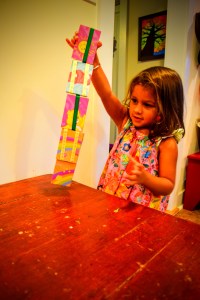We have some glorious October weather in Virginia this week…cool mornings, sunny days, and brilliant leaves falling from our trees! L’s been painting outside these days, in a world of October color! Yesterday she made a beautiful fall tree using acrylics, melted crayons, and a sprinkle of “leaf glitter” (tiny pieces of actually leaves). The outcome is beautiful!!! I made a similar piece last year that I also adore…the process is as much fun as the piece of art itself!
Materials needed:
- canvas (you could do this on cardboard too!)
- acrylic paints (blues, white, brown)
- crayons (oranges, yellows, and red)
- knife and cutting board
- oven
*A tip when buying crayons for this project…when you’re looking for orange crayons, buy a box of 24 crayons. The larger boxes contain more crayons, but not any more orange and yellows!!! We always seem to run out of orange crayons this time of year!
First, have your child paint their canvas blue. We like to use some darker and some lighter blues, mixing them all together.
Next, have them paint a few white, fluffy clouds.
As the sky is drying, sit back and look at the trees with your child. Point out how the trunk is usually straight and thick. As you move up the tree, the branches get smaller and smaller, and they get more squiggly!
As you continue to discuss trees and their features, lay out a few various-sized paintbrushes. Have your child put them in order from biggest to smallest. Now they know which paintbrush to use for their tree’s trunk and all its branches!
Time to paint the tree!
The next step is a little “out of the box,” but that’s what makes it so great! Have your child pick out which crayons are the colors of the fall leaves before them. Using a sharp knife and a cutting board, remove the paper off the crayons and chop the crayons up into tiny pieces. I think we used half a lime-green crayon, one yellow, three or four oranges, and one red crayon.
Lay the painting down on a flat surface and have your little one sprinkle the crayon shavings all over the trees branches. L also crumbled up an actual leaf from the yard and sprinkled some of it among the crayon pieces. It’s a minor detail, but it’s my favorite. I’ll always remember this day and where L made her Fall Tree.
Once the crayon shavings are all dispersed, put your painting into the oven at 200 degrees for about 3-5 minutes. Watch the pieces as they melt. (Our painting was too big to fit in the oven this time, so I carefully held it under the broilers with the oven set on broil. I did one end, then turned it around and did the opposite.) When you remove the artwork from the oven, be careful to hold it flat and steady…until the crayon wax hardens, the wax will drip if it is tilted at all.
Isn’t the outcome gorgeous? It’s perfectly imperfect…just like a fall leaf.
If you think this is just a craft for kids, you’re wrong…you can totally do this as well! “Mixed-media Fall Art” is fun for anyone and everyone! Enjoy!!!
































































































































































































